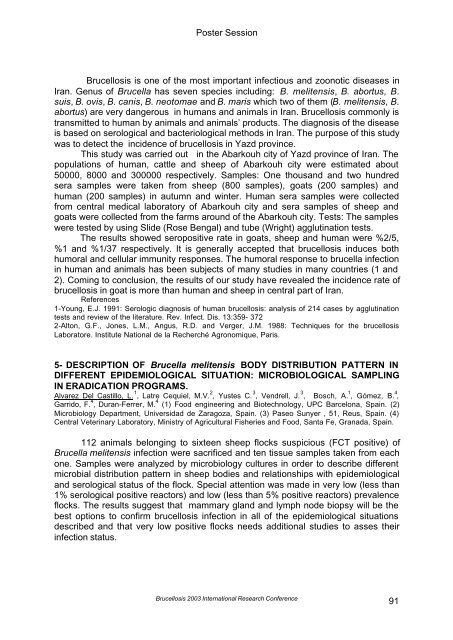Brucellosis 2003 proceedings - PHIDIAS
Brucellosis 2003 proceedings - PHIDIAS
Brucellosis 2003 proceedings - PHIDIAS
You also want an ePaper? Increase the reach of your titles
YUMPU automatically turns print PDFs into web optimized ePapers that Google loves.
Poster Session<br />
<strong>Brucellosis</strong> is one of the most important infectious and zoonotic diseases in<br />
Iran. Genus of Brucella has seven species including: B. melitensis, B. abortus, B.<br />
suis, B. ovis, B. canis, B. neotomae and B. maris which two of them (B. melitensis, B.<br />
abortus) are very dangerous in humans and animals in Iran. <strong>Brucellosis</strong> commonly is<br />
transmitted to human by animals and animals’ products. The diagnosis of the disease<br />
is based on serological and bacteriological methods in Iran. The purpose of this study<br />
was to detect the incidence of brucellosis in Yazd province.<br />
This study was carried out in the Abarkouh city of Yazd province of Iran. The<br />
populations of human, cattle and sheep of Abarkouh city were estimated about<br />
50000, 8000 and 300000 respectively. Samples: One thousand and two hundred<br />
sera samples were taken from sheep (800 samples), goats (200 samples) and<br />
human (200 samples) in autumn and winter. Human sera samples were collected<br />
from central medical laboratory of Abarkouh city and sera samples of sheep and<br />
goats were collected from the farms around of the Abarkouh city. Tests: The samples<br />
were tested by using Slide (Rose Bengal) and tube (Wright) agglutination tests.<br />
The results showed seropositive rate in goats, sheep and human were %2/5,<br />
%1 and %1/37 respectively. It is generally accepted that brucellosis induces both<br />
humoral and cellular immunity responses. The humoral response to brucella infection<br />
in human and animals has been subjects of many studies in many countries (1 and<br />
2). Coming to conclusion, the results of our study have revealed the incidence rate of<br />
brucellosis in goat is more than human and sheep in central part of Iran.<br />
References<br />
1-Young, E.J. 1991: Serologic diagnosis of human brucellosis: analysis of 214 cases by agglutination<br />
tests and review of the literature. Rev. Infect. Dis. 13:359- 372<br />
2-Alton, G.F., Jones, L.M., Angus, R.D. and Verger, J.M. 1988: Techniques for the brucellosis<br />
Laboratore. Institute National de la Recherché Agronomique, Paris.<br />
5- DESCRIPTION OF Brucella melitensis BODY DISTRIBUTION PATTERN IN<br />
DIFFERENT EPIDEMIOLOGICAL SITUATION: MICROBIOLOGICAL SAMPLING<br />
IN ERADICATION PROGRAMS.<br />
Alvarez Del Castillo, L. 1 , Latre Cequiel, M.V. 2 , Yustes C. 3 , Vendrell, J. 3 , Bosch, A. 1 , Gómez, B. 4 ,<br />
Garrido, F. 4 , Duran-Ferrer, M. 4 (1) Food engineering and Biotechnology, UPC Barcelona, Spain. (2)<br />
Microbiology Department, Universidad de Zaragoza, Spain. (3) Paseo Sunyer , 51, Reus, Spain. (4)<br />
Central Veterinary Laboratory, Ministry of Agricultural Fisheries and Food, Santa Fe, Granada, Spain.<br />
112 animals belonging to sixteen sheep flocks suspicious (FCT positive) of<br />
Brucella melitensis infection were sacrificed and ten tissue samples taken from each<br />
one. Samples were analyzed by microbiology cultures in order to describe different<br />
microbial distribution pattern in sheep bodies and relationships with epidemiological<br />
and serological status of the flock. Special attention was made in very low (less than<br />
1% serological positive reactors) and low (less than 5% positive reactors) prevalence<br />
flocks. The results suggest that mammary gland and lymph node biopsy will be the<br />
best options to confirm brucellosis infection in all of the epidemiological situations<br />
described and that very low positive flocks needs additional studies to asses their<br />
infection status.<br />
<strong>Brucellosis</strong> <strong>2003</strong> International Research Conference<br />
91
















